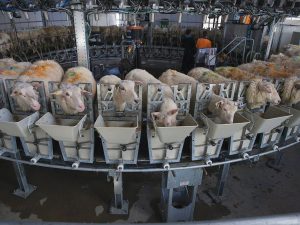Spring flush has arrived, and discounted spot loads of milk are available. Cream multiples, a pricing mechanism for milkfat, are also moving lower on ample fat supplies. This apparent surplus is happening when U.S. dairy producers are milking fewer cows than a year ago and highly pathogenic avian influenza (HPAI), which can negatively impact milk production, is being confirmed in more dairy herds.
According to Betty Berning, analyst with the Daily Dairy Report, the total pounds of fat being produced are higher than a year ago, but milk production and total pounds of protein are down. “With tempered demand for cheese, nonfat dry milk, and sweet dry whey powder, which all use protein and skim-solids, declining protein levels have not yet impacted markets,” Berning said. “However, if demand picks up, manufacturers could be forced to scramble to find enough protein and skim solids to keep up.”
International demand for U.S. dairy products has not kept pace with year-earlier levels for more than a year, but signs are starting to emerge that demand for U.S. dairy could soon pick up, Berning noted. For example, U.S. dairy exports in February were higher on a year-over-year basis, but it remains to be seen whether international buying will continue to best year-ago levels going forward, she said.
In 2023, demand from Mexico was a bright spot for U.S. dairy exports, and the country has continued to aggressively buy U.S. dairy products in 2024. Dairy shipments to Southeast Asia also improved in February. “If that momentum continues, Class III prices, which are now at less-than-breakeven, could increase,” Berning said.
Another factor that could undergird milk prices is an ongoing contraction in the U.S. dairy herd, according to Berning. However, slaughter rates this year have slowed from the rapid pace set in the first eight months of 2023. For the week ending March 29, 123,800 fewer dairy cattle, a dop of 16.5%, were sent to packing plants, compared to the comparable week in 2023.
“While prices for live cattle have fallen in recent weeks, they remain at elevated levels historically, and they provide a sizeable paycheck for producers sending cows to slaughter. With the smaller herd size and higher heifer prices, though, the opportunity cost of sending a cow to slaughter has increased from a year ago. This year’s cull rates will likely continue to lag previous years as producers work to keep their barns full,” Berning said.
Another unknown is HPAI, but “at this point, it has not had much of an impact on milk production or milk markets,” Berning noted. “The illness continues to pop up in more states, with cases reported in North Carolina and South Dakota last week. Some states have even started to curtail the movement of cattle to prevent the disease from spreading, she said, but because waterfowl are the carriers of HPAI, more cases are likely as migration continues.
You can now read the most important #news on #eDairyNews #Whatsapp channels!!!
🇺🇸 eDairy News INGLÊS: https://whatsapp.com/channel/0029VaKsjzGDTkJyIN6hcP1K
















